Dental Implants and Oral Reconstruction
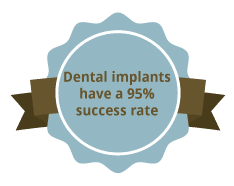 Dental implants are a constantly changing field in dentistry. Dr. Haggerty specializes in the placement of dental implants and has numerous book chapters and publications in peer-reviewed journals in the fields of dental implants and bone grafting. Dr. Haggerty has served as a reviewer for the Journal of Oral and Maxillofacial Surgery (JOMS) since 2012 and has won the coveted award of “Top Implant Reviewer” twice for his work regarding dental implant and bone grafting surgery.
Dental implants are a constantly changing field in dentistry. Dr. Haggerty specializes in the placement of dental implants and has numerous book chapters and publications in peer-reviewed journals in the fields of dental implants and bone grafting. Dr. Haggerty has served as a reviewer for the Journal of Oral and Maxillofacial Surgery (JOMS) since 2012 and has won the coveted award of “Top Implant Reviewer” twice for his work regarding dental implant and bone grafting surgery.
Dr. Haggerty and the staff at Lakewood Oral and Maxillofacial Surgery Specialists are committed to providing you with the latest treatments and technologies available in the field of dental implantology. Our state of the art facility is equipped with an in-office cone beam CT scanner and i-Tero digital impression scanner to generate dental models and custom implant guides to ensure precise implant placement.
FAQ Regarding Dental Implants
What are dental implants?
Dental implants are one of the very best ways to replace missing teeth. A dental implant is an artificial tooth root that can be placed within your jawbone in order to replace missing teeth. Dental implants are made of titanium or titanium-zirconium, just as many other implantable medical devices are.
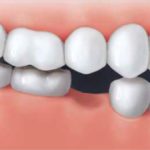
Figure 1-1. A missing lower tooth
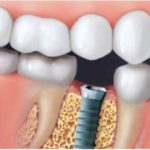
Figure 1-2. A dental implant is placed after a tooth is extracted.
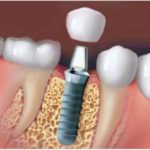
Figure 1-3. After several months of healing, an abutment and a custom dental crown are placed onto the implant to replace the missing tooth.
What are the benefits of dental implants?
Dental implants are one of the best ways to replace missing teeth. Dental implants look and feel like natural teeth, help to prevent/minimize bone loss to the jaw, maintain the position of adjacent teeth, decrease the wear and tear on adjacent teeth, improve your appearance and improve your ability to chew and enjoy food.
What percentage of patients are satisfied with their dental implants?
According to a study performed in 2009 (the Riegl Study), 98% of dental implant patients are “satisfied” or very satisfied” with their dental implants.
Is a dental implant right for me?
Dental implants are ideal for patients over the age of 18 with one, multiple or all missing teeth.
What is the success rate of dental implants?
Dental implants have an overall success rate of around 95% in healthy individuals.
What are the effects of missing teeth?
Tooth loss can have many negative effects on your oral health, to include bone loss, movement of your other adjacent teeth, changes to your bite and damage to adjacent teeth as they increase their use in the oral cavity.
Figures 2-1 and 2-2. When a tooth is extracted, the adjacent teeth will try to compensate by moving into the space of the missing tooth/teeth, often resulting in an altered bite and additional gaps or spaces within your smile.
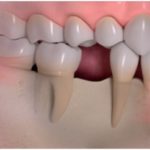
Figure 2-1
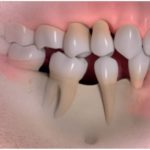
Figure 2-2
What happens after a tooth extraction (the need for grafting)?
Once the teeth are lost, a dynamic, continuous resorption of the surrounding bone occurs. Early implant placement can slow bone resorption and decrease tissue shrinkage. In certain instances, additional bone grafting is needed to restore lost bone volume so that dental implants can be placed in the ideal position for your dentist.
Dental implants are used in a variety of situations to replace missing teeth.
Dental implants can be used to replace a single missing tooth, multiple missing teeth or to add support and anchorage to your denture when all teeth are missing.
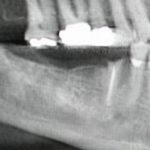
Patient presents with a failing three-unit bridge to the lower jaw.
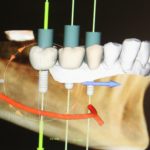
The teeth are extracted and the case is worked up with our software program for the placement of three dental implants to replace the failed dental bridge.
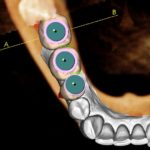
The teeth are extracted and the case is worked up with our software program for the placement of three dental implants to replace the failed dental bridge.
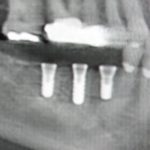
Film showing ideal placement of implants to the lower jaw.
Implant vs. Bridge
A bridge replaces missing teeth by attaching to nearby teeth and having an artificial or fake tooth over the area of missing teeth. Bridges require cutting and shaping of adjacent, uninvolved teeth for the placement of a bridge. Dental implants can placed directly in the area of the missing tooth/teeth and require no shaping or modifying of the adjacent teeth.
A bridge requires the cutting and shaping of adjacent, uninvolved teeth before it can be glued onto the adjacent teeth.
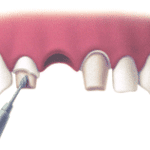
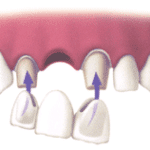
Implant Supported Denture vs. Traditional Denture
Once the teeth are lost, a dynamic, continuous resorption process of the jawbone occurs, this process is accelerated by denture wear. Resorption of the jaw bone after tooth extraction occurs 4 times faster in the mandible than in the maxilla. The end result is a loss of both the height and width of the mandible, which results in decreased retention of conventional dentures. Dental implants will allow a foundation for dentures to anchor to and thus provide added stability and forces to resist displacement while eating and speaking
What is a intra oral digital impression (i-Tero) scanner?
A intra oral digital impression scanner allows our office to take impression of your teeth without placing impression material into your mouth. The intra oral digital impression scanner allow us to make custom guides that are specific to each patient in order to place dental implants in the ideal position for your dentist.
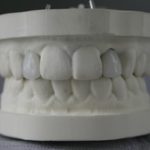
A 3D model is printed from the i-Tero digital scanner that allows your dentist to create custom crowns for your dental implants.
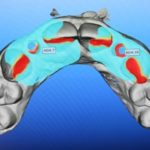
An intra oral digital impression is taken with the i-Tero scanner.
What if I smoke?
Dental implants can be placed in patients who smoke. Dental implants in non-smokers traditionally enjoy a success rate of 95%. This success rate will decrease some in smokers.
What is a sinus lift?
For patients requiring dental implants in the upper jaw with significant bone loss, a sinus lift procedure may be needed. This procedure creates additional height in the upper jaw for ideal implant placement.
What does the surgeon do?
Lakewood Oral and Maxillofacial Surgery Specialists will place dental implants and perform any hard or soft tissue procedures in order to allow for the ideal placement of the crown by your dentist. After your implant placement, you will be seen in our office for routine check-ups until it is time to place the final crown on your implant.
What does my dentist do?
For patients missing a single tooth, your dentist will make and place a natural looking tooth crown on top of your dental implant. For patients missing multiple or all teeth, your dentist will make and place implant supported bridges, removable partial or complete dentures and non-removable (fixed) dentures.
What is a Cone Beam CT (CBCT) scanner?
A cone beam CT scanner is an in-office CT scanner that allows us to gather information regarding your exact anatomy and bone quality prior to implant placement. With the use of our cone beam CT scanner we can create custom guides based on your exact anatomy to predictably and precisely place your dental implant(s).
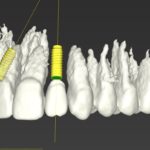
A cone beam CT scanner allow us to gather information prior to implant placement and to create custom guides to allow for ideal implant placement.
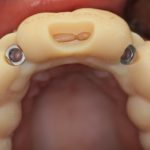
A custom implant guide is made based upon the data collected from the cone beam CT scanner.
Advantages of Dental Implants
Bone preservation.
After tooth loss, a predictable pattern of bone loss follow as the bone is no longer being stimulated by the tooth root. Dental implants allow for increase load on the jaw bone and help to retard bone loss and preserve jaw bone.
Unaffected adjacent teeth.
Unlike dental bridges, the placement of dental implants does not require the removal of tooth structure and the fabrication of dental crowns on adjacent teeth.
Maintaining space.
Dental implants prevent the migration of adjacent teeth into the spots of missing teeth. Dental implants also prevent the supra eruption of opposing teeth into the sites of missing teeth.
Preparation for Dental Implants
Tooth extraction and socket preservation grafting.
When a tooth fails and is extracted, a predictable pattern of bone loss of bone loss occurs during the healing process. Significant bone loss to the tooth extraction site can prevent the placement of dental implants in their ideal position or can prevent the placement of dental implant period. If dental implant placement is ultimately desires, a socket preservation is typical undertaken to preserve and maintain bone volume for future implant placement. A socket preservation involves the extraction of the tooth and the immediate placement of a small amount of bone material into the tooth socket to maintain or augment the bone volume to allow for the placement of a future implant in the ideal position.
Bone augmentation/grafting.
If teeth have been missing for an extended period of time, there may not be sufficient bone volume for the placement of dental implants. Bone volume may be added through a variety of procedures to allow for the placement of dental implants. During your implant consultation, Dr. Haggerty will review various treatment options and possibilities with you.
Dental Implants VS. Dental Bridge
Dental bridges requiring the removal of tooth structure to adjacent teeth in order to glue a pontic (fake tooth) to replace the site of the missing tooth. Dental implants replace the missing tooth/teeth without the need to alter/damage the adjacent teeth.
Dental bridges do not allow for the vertical flossing. A special type of flossing is required to clean under a bridge as food typically becomes trapped under the fake tooth portion of the bridge. Dental implant allow for flossing in the same manner (vertical) as natural teeth.
The area of the missing tooth/teeth continues to undergo progressive bone loss as the are is not stimulated. Unlike dental bridges, dental implants retard bone loss and maintain bone volume.
Unlike dental bridges, dental implants feel more like natural teeth and typically enjoy a longer survival rate than dental bridges, especially when dental bridges are used to replace multiple missing teeth.
Dental Bridge Procedure
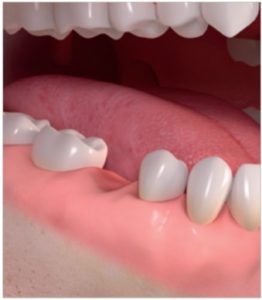
An image depicting a missing tooth in the lower jaw.
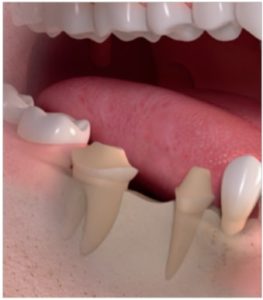
To replace a missing tooth with a dental bridge, tooth structure must be removed from adjacent, uninvolved teeth in order to glue the bridge in place.
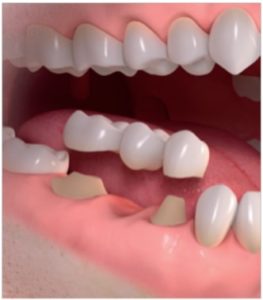
The dental bridge is then glued onto the adjacent, reshaped teeth.
Dental Implant Procedure
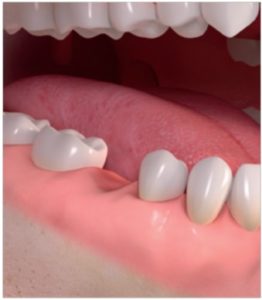
An image depicting a missing tooth in the lower jaw.
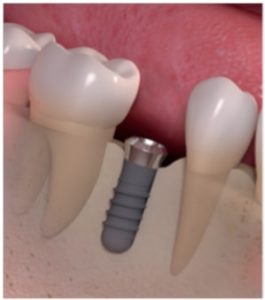
To replace a missing tooth with a dental implant, the implant can be placed in the site of the missing tooth WITHOUT involving the adjacent teeth or altering their structure.
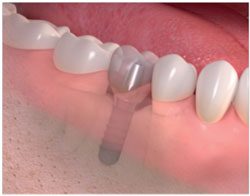
The dental crown is then placed onto the dental implant WITHOUT removing tooth structure or shaping the adjacent teeth.
Dental Implants and Dentures
Dental Implant Supported Dentures versus Conventional Dentures
The placement of 2-4 (lower jaw) or 4-6 (upper jaw) dental implants can significantly increase the retention of removable denture and notably increase the quality of life of denture patients.
Dental implants can minimize or eliminate:
- Loose dentures
- The displacement of denture while eating
- Pain from ill-fitting dentures
- The use of denture adhesives
- Bone loss
- Pressure sores
Dental implants can increase:
- Denture retention
- Patient diet
- Chewing ability
- Patient confidence
- Bone volume and minimize bone loss
Dental Implants for Denture Support
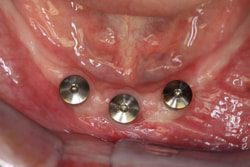
Three dental implants are placed to support a denture in the lower jaw.
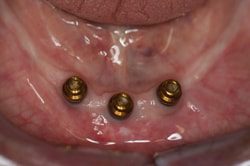
Locators are placed on the dental implants to hold the lower denture on place while eating.

The top view of the denture.
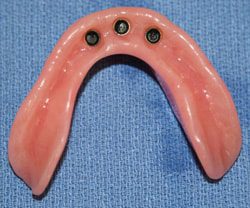
The lower denture is modified to allow it to snap onto the implants.
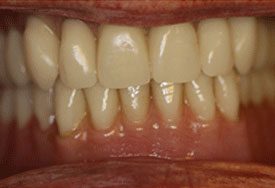
Final result.
For added retention of the lower denture, 4-6 implants and a custom bar may be placed.
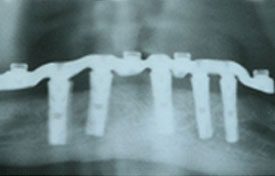
A film showing 5 dental implants inserted into the lower jaw and a custom bar spanning the dental implants.
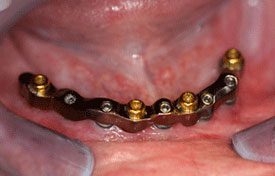
The bar in place with multiple snaps to engage the lower denture.
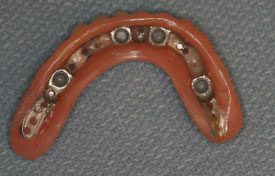
The lower denture has a customized undersurface that attached to the bar anchored on the dental implants. For this type of denture design, 4-6 dental implants must be placed to provide the most retention and stability of the lower denture.
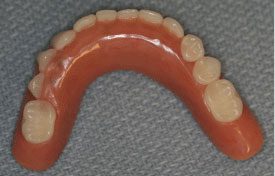
View of the lower denture

